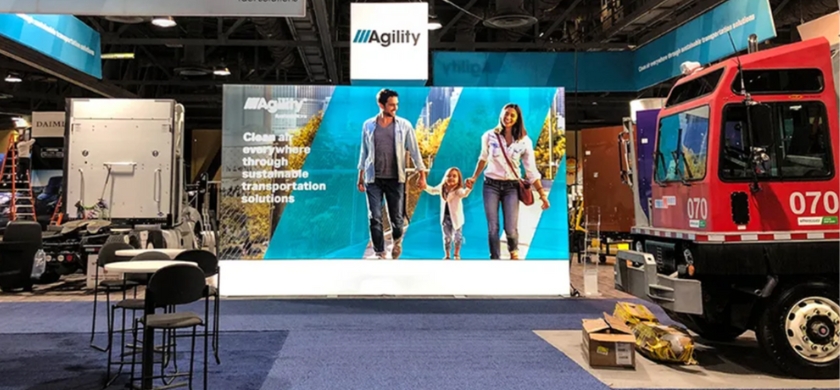How to Leverage IoT for More Engaging Attendee Experiences in Trade Show Booths
IoT technology is changing how companies do business, providing immense economic value and streamlining operations. Currently, 57% of North American and European businesses use IoT technology, a figure which will likely increase in the coming years. When it comes to booth designs for trade shows, IoT technology can be the key to driving engagement and profits.
Read on to learn four ways IoT technology can enhance booth designs for trade shows.
What is IoT Technology?
Internet of Things (IoT) technology refers to a network of devices that transfer and exchange data between each other using the Internet. IoT devices use software and sensors to gather and distribute information among the network.
Both businesses and private consumers see immense value in IoT technology. Recent data suggests that there are nearly 15 billion unique IoT devices worldwide, a number that is sure to increase in the coming years. IoT technology is in demand due to its ability to streamline operations, facilitate communication, and help improve profit margins. These benefits are especially apparent regarding booth designs for trade shows.
IoT technology is integral to any trade show booth design, as it has the capability to help exhibitors connect with event attendees. There are many potential applications for IoT technology when it comes to modern trade show booth design, but there are several that stand out as particularly effective.

4 Ways to Leverage IoT Technology in Trade Show Booth Design
When considering how the best trade show booth designs use IoT technology, some strategies stand out more than others. Here are four ways trade show exhibitors can use IoT technology to optimize engagement and impact.
1. Social Media Integration
Social media integration is one of the best trade show booth design ideas. Social media integration incorporates popular platforms — such as Facebook, Instagram, and X, among others — into the booth experience, giving exhibitors the power to interact with attendees in real-time. Exhibitors can display live social media feeds and interact with users worldwide, improving overall engagement with the target audience.
Social media integration provides companies with a direct channel to showcase their products or services to a broader audience, as popular social networks increase brand visibility and connect users who can’t attend the trade show in person. Based on instant feedback, brands can adjust their strategies at a moment’s notice. This connectivity enhances the exhibit’s impact and strengthens the company’s online presence and potential customer base.
2. Live-Streaming Display Screens
The best trade show booth designs, without fail, incorporate live-streaming display screens. Live-streaming display screens allow brands to showcase live demonstrations, presentations, promotional material, and even product launches in real time. These screens capture the attention of attendees and contribute to a more immersive booth experience. Best of all, trade show exhibitors can change the content on each screen at a moment’s notice, keeping their display’s messaging relevant and responsive to audience feedback.
Live-streaming display screens also allow companies to reach potential customers beyond the trade show itself. Brands can broadcast their activities to online audiences, maximizing exposure and engagement. In this sense, live-streaming display screens, as a part of a modern trade show booth design, can contribute to a larger marketing strategy.

3. Integration of Virtual Technologies (AR & VR)
Integrating virtual technologies such as Augmented Reality (AR) and Virtual Reality (VR) in booth designs for trade shows is an often overlooked, yet truly effective, method that brands can use to drive engagement and results. AR displays overlay digital information onto a physical environment, enhancing product displays with interactive elements or providing additional information. VR, on the other hand, immerses attendees in a virtual experience using dedicated hardware, enabling them to explore products or environments like hotel rooms in a simulated but highly realistic setting.
These technologies provide a unique way for exhibitors to showcase products or services. Virtual demonstrations, walkthroughs, and simulations draw customers in and facilitate a greater degree of engagement than more conventional methods. However, digital audiences can also engage with virtual demonstrations, expanding the brand’s reach beyond the physical trade show.
4. Digital Touchpoints to Collect Trade Show Attendee Information
Touchpoints are interactive kiosks and mobile devices that allow trade show attendees to provide their contact information, personal preferences, and general interests. Brands can use this crowdsourced data to personalize interactions, recommending relevant content for specific types of customers to improve engagement and impact. It’s a seamless way to provide a more tailored experience for trade show guests.
Companies that use digital touchpoints to collect attendee information can profit as a result. By capturing attendee data through touchpoints, vendors gain more than just the ability to tailor marketing for specific customers. They can provide unique product demonstrations and other forms of personalized content, increasing the likelihood of generating successful leads. Vendors can also use data gathered from touchpoints to conduct post-event follow-ups and surveys, all part of a broader strategy to build lasting customer relationships.
High Speed Internet is Critical for Trade Show Booth Design IoT Integration
Implementing IoT technology for trade show booths can help gather valuable data, engage with your audience, and showcase your products through live streams, social media interaction, and so much more. But IoT technology also demands a lot of bandwidth and security, requiring reliable and high-quality convention center WiFi and smart technology solutions.
Hospitality Network has extensive experience in supporting IoT applications for trade show exhibitors, having installed and managed the WiFi network for the Las Vegas Convention Center, one of the largest and most advanced trade show venues in the world. We can help you design and implement a custom IoT solution that meets your venue’s needs and budget. Take the first step with Hospitality Network and request a consultation today.

